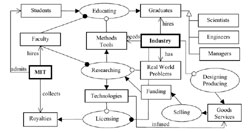| home this issue archives editorial board contact us faculty website |

| Vol.
XVII No.
4 March/April 2005 |
| contents |
| Printable Version |
Professors of the Practice:
Bridging Industry and Academia
This is the second article in a series on non-traditional faculty appointments at MIT. In the first article (MIT Faculty Newsletter , Vol. XVII No. 2, November/December 2004) we discussed how Professors of the Practice are bringing a sense of the Real World to MIT thanks to their extensive professional experience. In this article we discuss in more detail the complex relationship between academia and industry, and argue that Professors of the Practice are able to act as a unique bridge between MIT and industry.
Industry and Academia: Complex Interactions
Some may say that it is futile to map the intricate web of relationships between academia and industry because of the dynamic nature of interactions. Others may argue that close ties between industry and academia are undesirable because they create conflicts of interest (of a primarily financial nature) and rob the university of its freedom to pursue "pure" research independent of economic interests. Although everyone is entitled to their opinion, a close association between academia and industry is undeniable, both in fact and tradition. This is particularly true for MIT:
- MIT maintains strategic research alliances with a number of corporations such as Microsoft, Ford, and Dupont, among others.
- MIT has strong internal organizations that foster collaborations and exchange of personnel, research ideas, and results, as well as licensing of new technologies: the Office of Corporate Relations, the Industrial Liaison Program, the Technology Licensing Office, and the Industrial Performance Center.
- MIT features educational programs focused on mid-career to executive level students: the Leaders for Manufacturing Program, the MIT Sloan Fellows program in Innovation and Global Leadership, and the System Design and Management program.
- MIT's research is funded by industry on the order of $60-80 million per year, which has historically represented between 11.4% (2004) and 19.7% (2000) of the Institute's total research expenditures.
- A 1997 study conducted by BankBoston revealed that MIT graduates have founded 4,000 companies, creating 1.1 million jobs worldwide and generating annual sales of $232 billion.
- MIT has the ability to appoint exceptional industrial leaders as Professors of the Practice. This gives these individuals the ability to pursue a second career in academia with rights and obligations equivalent to a tenured faculty member. But what's in it for MIT?
How does MIT interact with industrial firms?
The primary purpose of industry is to design, produce, and sell goods (products) and services for a profit. In order to do this they hire a workforce, consisting of scientists, engineers, and managers, among others. These graduates are primarily provided by the Institute through the educational process, which transmits to them a body of knowledge about the workings of the physical world and, perhaps more importantly, methods and tools to design and produce better goods and services. In the messy reality of industrial practice, situations frequently arise which are not properly addressed by existing methods, tools, or technologies. It is the existence of these real-world problems which gives the impetus for new research, fueled directly by industry funding, and in some cases indirectly via government funding. MIT hires faculty to educate admitted students and conduct research which will produce new methods, tools, and technologies to address important problems. Occasionally technologies are licensed by industry for a royalty in order to infuse them in new or existing goods and services.

The figure shows the relationships between MIT and industry in a simplified fashion as an Object Process Diagram. In this view rectangles are objects and ovals represent processes. Various links connect objects to processes and objects to objects.
What makes MIT different from many other universities, is that both teaching and research are derived from real-world problems and the desire to have an impact on industrial practice. In this context, Professors of the Practice can play a catalytic role as members of our faculty. As former decision-makers and leaders, they have an in-depth understanding of current, past, and potential future problems that industry is facing. They can transmit years of experience and hard lessons learned to our students. They can act as messengers for the Institute and carry new research results back to industry with credibility and increased awareness of new thoughts and ideas born in the less constrained world of academia. What follows is a brief perspective on two of our colleagues, Prof. Chris Magee and Prof. Debbie Nightingale.
| Back to top |
Prof. Christopher Magee
Chris Magee sees parallels between fundamental research in engineering science and research in large-scale systems, which are often designed and/or operated by industry and government. His background in materials science taught him that the properties and behavior of a material are not only a function of its molecular structure, but also shaped by the processes (e.g., heat treatments) that are applied to it throughout its life. Similarly, he sees intricate relationships between form and function in complex systems and products, which also exhibit strong path dependencies, which are introduced during the product development process.

(click on image to enlarge)
Despite early opportunities to join academia in the 1960s and '70s, Prof. Magee decided to make his career in industry where he saw more of an opportunity to make a real-world impact. After joining Ford Motor Company in 1966, he started in a fundamental research position in materials science. As he gradually moved to greater levels of responsibility in the company, his work also became more applied. This included nonlinear finite element modeling, the use of lightweight materials in car bodies and crashworthiness, among others. Finally, in 1981 he became the manager of advanced vehicle and concept development at Ford. During the 1980's and 1990's he led the technical development of major new vehicle programs such as the Explorer, Mondeo, Focus, F-Series trucks and the new Taurus, among others. At the end of 2001, he retired from Ford, but wanted to remain active as an academic to continue to learn and to share his insights with students and others operating at the intersection of industry and academia.
At MIT, Prof. Magee enjoys the intellectual stimulation he gets from teaching both at the graduate and undergraduate level (in Mechanical Engineering and in the UPOP program) as well as the ability to pursue his research. He is helping shape an intellectual agenda for the field of Engineering Systems, e.g., through the doctoral seminar ESD.83. This course focuses on doctoral-level analysis of scholarship on key concepts such as complexity, uncertainty, fragility, and robustness, as well as related areas such as systems engineering, systems dynamics, agent modeling, and systems simulations.
Prof. Magee candidly admits that some aspects of being a Professor of the Practice are challenging; one of these is the slow pace of decision-making in academia. Whereas decisions in industry are made frequently, with only partial information and under considerable time pressure, this is rarely the case in a university setting. At a place like MIT, the power of individual, executive decision-makers is replaced by the need for extensive deliberation and consensus building among the faculty. This can be frustrating at times, but it is also essential for the long-term survival of the university.
Dr. Magee has a Ph.D in Metallurgy & Materials Science from Carnegie Mellon University and an MBA from Michigan State University. Among his areas of expertise are vehicle design, systems engineering, application of computer-aided engineering, and computer-aided design. The application of materials, vehicle crashworthiness, manufacturing-product interface, and all aspects of the product development process are also areas of significant personal experience and knowledge. Dr. Magee is a member of the National Academy of Engineering, a Fellow of ASM, and a Ford Technical Fellow. He is currently a Professor of the Practice with dual appointments between the Department of Mechanical Engineering and the Engineering Systems Division. He is director of the Center for Innovation in Product Development (http://cipd.mit.edu).
Prof. Deborah Nightingale
Deborah Nightingale contends that in some cases industry is actually ahead of academia. One area where this might apply is Integrated Product and Process Development. Industry has incorporated collaborative development processes involving design engineers, manufacturing engineers, suppliers and customers long before we began teaching this approach in university courses. Should academia and MIT, in particular, give up any research activities in such areas?
Quite the contrary, says Prof. Nightingale.
Her philosophy is to use industry as a laboratory, as a research testbed so to speak.
This has been the main thrust of the Lean Aerospace Initiative which is now headed by Nightingale as co-director. The Lean Aerospace Initiative (LAI) was born out of practicality and necessity, as declining defense procurement budgets collided with rising costs and military industrial overcapacity in the 1990s, prompting a new defense acquisition imperative: affordability rather than performance at any cost (http://lean.mit.edu).
Over the last several years, LAI's efforts have been broadened beyond manufacturing to include applying lean principles to the entire enterprise, including product development, supply chain management, software development and enabling administrative processes such as IT, human resources, and finance. It is often at the interfaces of these enterprise processes where the key opportunities and research issues lie. The dominant research paradigm in LAI is the case study method. In this context, however, Prof. Nightingale contends that traditional academia is often working in the "silos", rather than across organizational boundaries. Also, conventional research is primarily focused on documenting and collecting data on historical facts and describing pathologies in current industrial settings. Her ambition and research methodology go beyond this by (i) creating new enterprise operating models, (ii) identifying pockets in industry and government where these operating models can be implemented as prototypes, (iii) observing and measuring the impact of these new operating models, and (iv) feeding the resulting insights back to key decision makers and into future projects.
The results of this research also flow into her teaching at the Institute. Her course ESD.61J "Integrating the Lean Enterprise" addresses some of the important issues involved with the planning, development, and implementation of lean enterprises. This course started in 1998 as a seminar in Aeronautics & Astronautics and has since expanded to include students in various graduate programs in the Engineering Systems Division as well as other engineering disciplines. People, technology, process, information and leadership dimensions of an effective lean enterprise are considered in a unified framework. This kind of broad learning experience is particularly popular with students who possess prior work experience (e.g. those in the System Design and Management Program or the Leaders for Manufacturing Program). Since most of MIT's students go into industry positions, Professors of the Practice can also serve as role models and mentors to both graduate and undergraduate students.
Prof. Nightingale holds a PhD in Industrial and Systems Engineering from Ohio State University, and MS and BS degrees in Computer and Information Science. Prior to joining MIT, she headed Strategic Planning and Global Business Development for AlliedSignal Engines. Prior to joining AlliedSignal she worked as a researcher in the Human Engineering Lab at Wright Patterson AFB. Dr. Nightingale is a member of the National Academy of Engineering and a Past-President and Fellow of the Institute of Industrial Engineers.
| Back to top | |
| Send your comments |
| home this issue archives editorial board contact us faculty website |